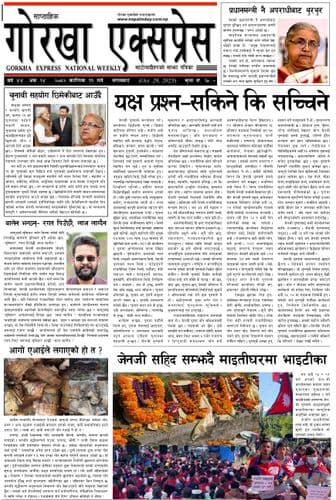
"If the military supports the monarchy, the role of political parties will become secondary"
This political analysis covers the movement for the restoration of the monarchy in Nepal, international intervention, and future possibilities. The movement initially focused on "peaceful" protests starting from May 29, but after the violent incident on Chait 15, the strategy has changed. Discussions held by American citizens with Jagaman Gurung in Gorkha indicate an active U.S. role. There are allegations that the U.S. is trying to advance its strategic interests by increasing instability in Nepal, particularly by uniting pro-monarchy factions.
India and China have shown clear differences in their responses. While India supports a "Hindu republic," it opposes the restoration of the monarchy, whereas China insists on maintaining the republic. Due to pressure from these two powers, the U.S. is promoting the Nepali Army as an alternative force. The Nepali Army’s "indirect support" and the arrival of American troops could influence the direction of the movement. The early arrival of the monsoon by a week might also change the dynamics of the protests.
The internal strategy of the movement aims to amend the constitution and restore a Hindu monarchy. Jagaman Gurung and a faction of the Rastriya Prajatantra Party are leading this effort. The U.S. interest lies in reducing Indian and Chinese influence in Nepal while strengthening military/monarchy-aligned forces and presenting the monarchy as a symbol of "stability." After a secret meeting in Gorkha, a statement was issued claiming, "The republic will end after May 29."
Amid triangular pressure, the interests of the U.S., India, and China are clashing. India has expressed concern over former pro-India leaders like Jagaman Gurung falling under American influence. The Nepali Army’s historical ties to the monarchy and the pro-monarchy sentiments among some current generals raise the possibility of the military supporting a constitutional monarchy. If the movement turns violent, the army could intervene in the name of "maintaining peace and order" and take control of the government.
Possible future scenarios include a 50% chance of the monsoon weakening the protests, 30% chance of military intervention, and 20% chance of an India-U.S. confrontation. Pro-monarchy forces are trying to build a mass movement by combining religion, nationalism, and military support. The U.S.-India-China rivalry could turn Nepal into a proxy battleground. "The military's decision will be decisive if it supports the monarchy, the role of political parties will become secondary."
King Gyanendra’s 2017 visit to China played a key role in his political resurgence. During meetings with Chinese leadership, assurances were given regarding Nepal’s cooperation on the Tibet issue, while China hinted at major infrastructure investments in Nepal. After this visit, Gyanendra attempted to establish parallel contacts with India to secure bilateral security guarantees. Public outreach campaigns under the guise of religious tours in the Terai region were used to gauge the monarchy’s popularity.
Currently, countries like the U.S., India, Japan, and South Korea are trying to bring Nepal into their geopolitical spheres of influence. The U.S. is increasing military aid, while China is developing infrastructure under the Belt and Road Initiative. Nepal faces the challenge of balancing foreign powers while safeguarding its sovereignty. In the coming days, the movement’s momentum, seasonal effects, the military’s behavior, and international pressures will determine the future of Nepal’s governance system.


